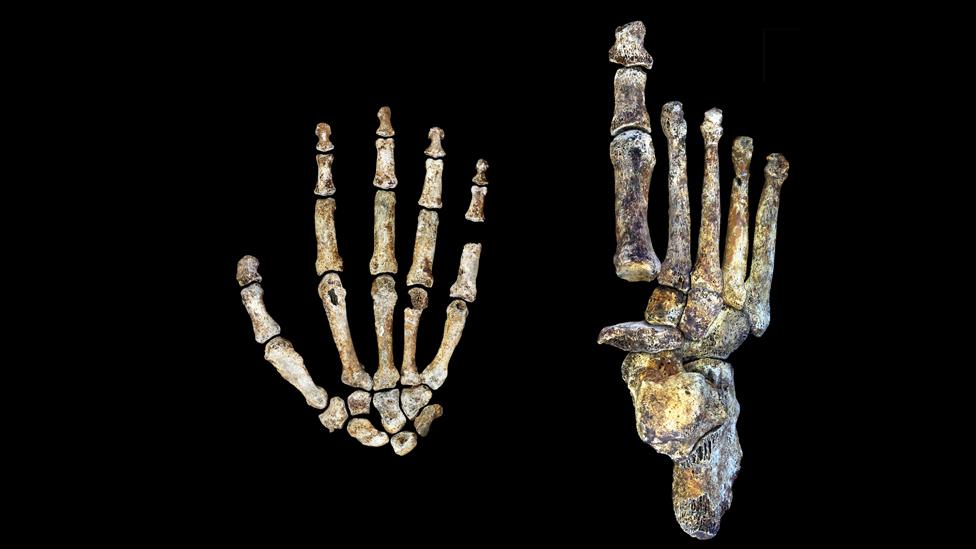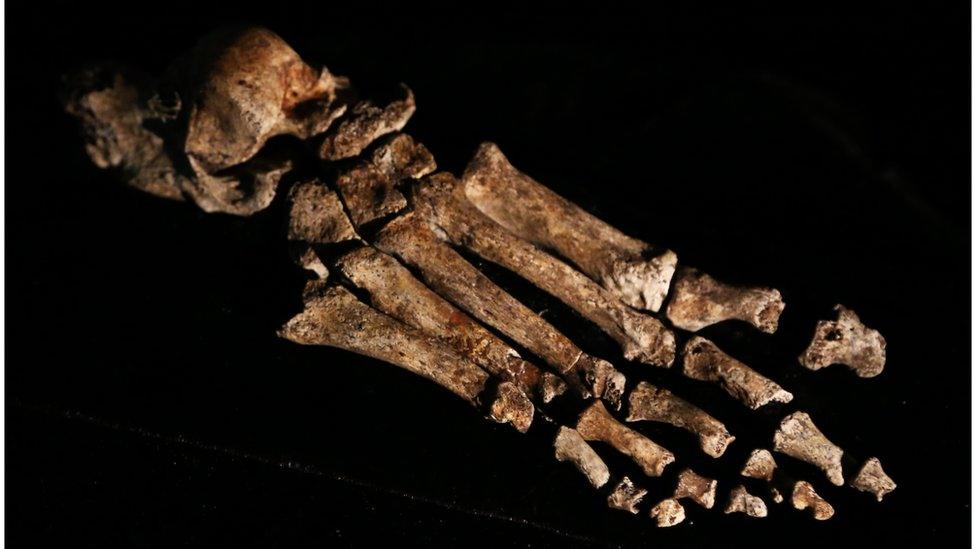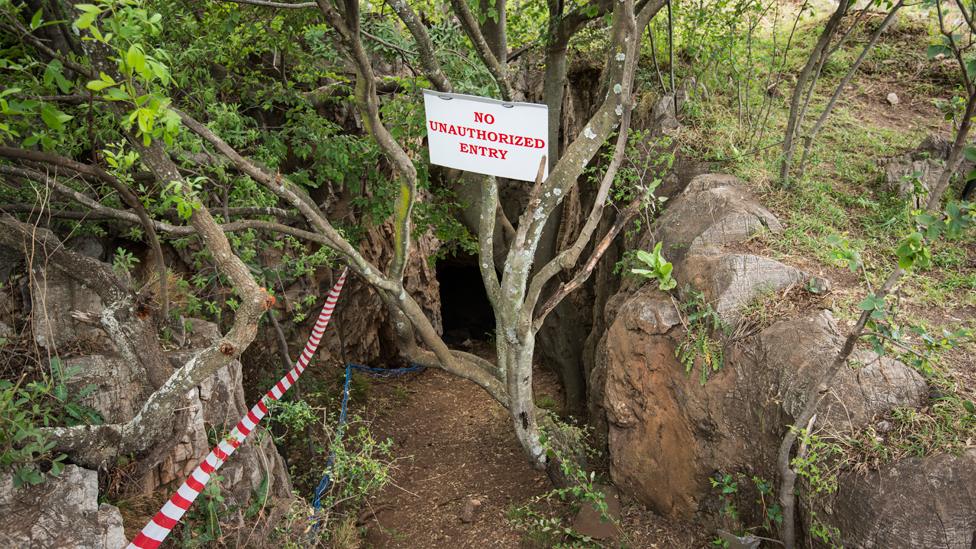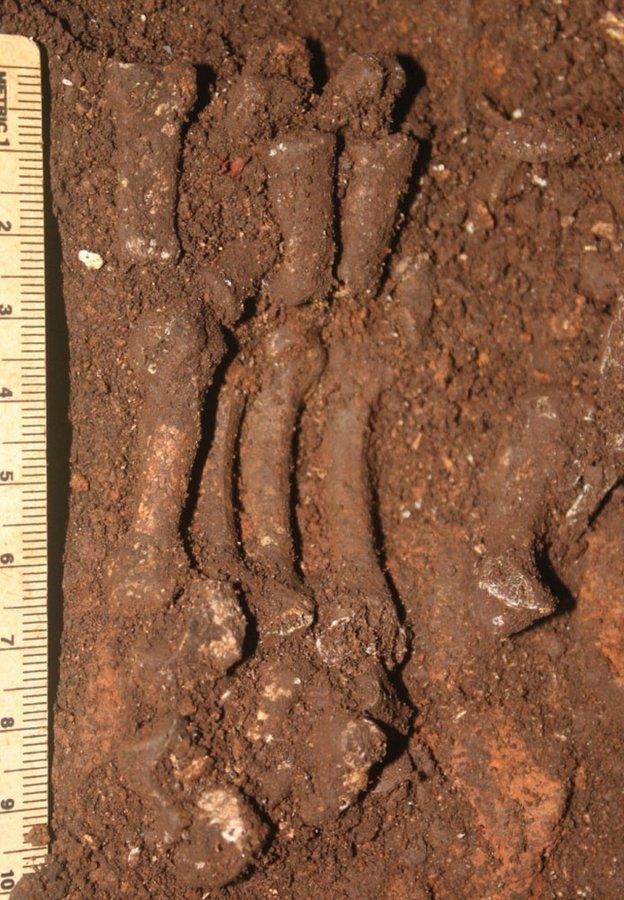Homo naledi: Hands, feet suggest 'jack of all trades'
- Published

The hand and foot are very modern-looking apart from the curvature in the fingers and the toes
The human ancestor Homo naledi was something of an all-rounder, able to move efficiently on the ground but also adept at climbing in trees.
Scientists have just published a second batch of papers on the creature whose remains were sensationally found deep inside a South African cave.
The scholarly articles focus entirely on naledi's hands, external and feet, external.
Its feet were clearly those of a walker while the hands had curved fingers to grasp and hold on to branches.
But the hands also show a remarkable level of modernity that is only really evident in late Homo species, such as today's humans and our now extinct cousins, the Neanderthals.
The architecture of our bones and muscles enables us to engage in very fine manipulation tasks. We can forcefully pinch our thumb and little finger together, for example - something that is much more difficult for relatively short-thumbed apes.
This is part of why we are so good at making and using tools.
The structure of Homo naledi's hands indicates it also probably had some of this capability, says Tracy Kivell from Kent University, UK.
"The features that we see particularly in the wrist, we've only ever found in Neanderthals and [modern humans], and we know that those are committed to using tools," she told BBC News.
"They make tools, complex tools, and use them all the time, enough so that it's actually changed their morphology.
"Perhaps naledi was using tools that were made out of different materials or doing some other forceful, precision-grip manipulations, but the most straight-forward explanation is that naledi is making and using tools."

A 3D print of the right hand. The naledi people stood about 150cm (5ft) in height
No tools were found with the hominin's remains inside the Rising Star Cave in the Cradle of Humankind World Heritage Site outside Johannesburg, so no direct association can be made.
That leaves room for uncertainty, and a conundrum: this was a creature that may have lived two million years ago with a brain comparable in size to a modern chimpanzee's. Would it really have had the cognitive capacity to be a skilled tool-user?
This puzzle may be answered in due course. Only a small fraction of the cave has been excavated, and future work could yet provide some tool discoveries.
Certainly, more naledi remains are a given. Bones from perhaps 15 or more individuals have so far been recovered.
These include nearly 150 hand-bone specimens, including the near-complete right hand of an adult. Its only missing feature is the pisiform - the little knobbly bone on the outside of the wrist.
As the Wits University-led scientists excavated the cave-floor sediments to reveal the hand, they scanned every step of the process to record each bone's exact position.
"The near-perfect articulation means that when that individual was put there or died there, the bones were not subsequently disturbed or moved. There can't have been water flowing through the cave, for example, because those little bones of the wrist and the finger-tips would have been the first to disappear," said Dr Kivell.

It is a foot of a creature that spent most of its time on the ground
Among the 107 foot-bones recovered at Rising Star is a well-preserved right adult foot.
Like the hands, the feet of naledi are predominantly modern human-like in their shape, and in their inferred function. In other words, naledi could walk very well.
But just like the hands, they differ from modern humans' feet in the curvature of the phalanges - the toe bones. The arch was lower, too.
"This was an animal that was bipedal; it was very comfortable on the ground," William Harcourt-Smith, from Lehman College CUNY and the American Museum of Natural History, told BBC News.
"You can imagine that during the day, when it was out and about, it was mostly on the ground. But for things like going to feed or to hide from predators, it would have gone into the trees, because we see that it has retained some of these more primitive features in the foot. So: much more bi-pedal than not, but not 100%."

There is more to come from the Rising Star Cave system
One of the big outstanding questions concerning Homo naledi is its precise position in time.
When the Wits team announced the discovery last month, no age was given for the remains. This is still being worked on.
But from the look of many body features, such as the shape of the chest and shoulders, the creature is assumed to sit at the base of the Homo family tree.
This may well change when the dating quest finally yields a result. Scientists may then learn that naledi, far from being two million years old, is actually a creature from much nearer in time.
This would provide echoes of the Indonesian species Homo floresiensis, external, which, despite having some very primitive traits, was shown to be living perhaps as recently as 12,000 years ago.
"And then you have a remnant lineage in South Africa, alongside other species that are much more advanced, hanging on and doing well quite late into the record. Again, that would speak to diversity and experimentation in the Homo genus," speculated Dr Harcourt-Smith.
"And then if naledi really is very old, it's fascinating too because it's something in South Africa rather than East Africa that is very distinct, and again points to a lot of experimentation in the emergence of Homo.
"So it's win-win whatever the dating shows."
Drs Kivell, Harcourt-Smith and colleagues have published their descriptions of the hands and feet in the journal Nature Communications.

The hand emerges from the cave sediment with the bones in position
Jonathan.Amos-INTERNET@bbc.co.uk, external and follow me on Twitter: @BBCAmos, external
- Published25 September 2015

- Published10 September 2015
